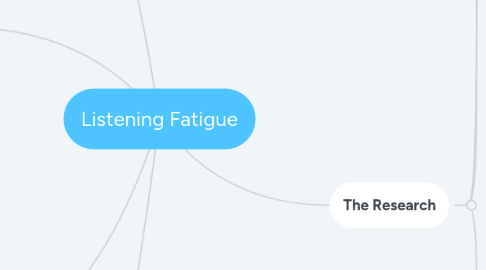
1. Listening-Related Fatigue in Children With Hearing Loss: Perspectives of Children, Parents, and School Professionals
1.1. By
1.1.1. Davis, Schlundt, Bonnet, Camarata, Hornsby and Bess, 2021
2. What is it?
2.1. Listening fatigue is when the listener is fatigued and is loosing auditory processing power, which can impair the listener's understanding of the auditory content.
2.2. Chronic fatigue can have negative social, emotional and cognitive impacts
2.3. I've experienced this many times being in the headphones for 12+ hours. It's how you feel at the end of a shoot day as a sound recordist.
2.4. Occurs faster when the listener is in a noisy environment.
3. Comping Strategies
3.1. Children w/HL request:
3.1.1. environmental modifications to the listening situation
3.1.2. Children w/HL have stated that they also zone out
3.1.3. putting head down on the desk
3.1.4. removing hearing device
3.2. Educators
3.2.1. some teachers give auditory breaks after lectures or audio heavy material
3.2.2. can pull out the child w/HL for individualized instruction for part of the school day
3.2.3. Children get preferential seating near the teacher
3.2.4. some teachers gave notes to the child with HL prior to the lesson
3.2.4.1. lesses the cognitive load of taking notes and listening at the same time!
4. Children w/HL ...
4.1. don't feel like they don't have control over their schedule... may not self advocate
5. The Research
5.1. Hornsby et al. 2017
5.1.1. collected subjective data from children with HL (n=60) and children without HL (n=43) and their parents using a fatigue scale (PedQ1-MFS).
5.1.1.1. RESULTS:
5.1.1.1.1. children with HL reported more fatigue than the control group, yet the differences were small (negligible??)
5.1.1.1.2. the fatigue in children with HL was equal to that of individuals with disorders and diseases where fatigue is the primary complaint (cancer).
5.1.1.2. NOTE: The PedQ1-MFS is a generic fatigue scale, not specific to listening fatigue.
5.1.1.2.1. For more information about this, read Davis et al., 2020
5.2. Hornsby & Kipp, 2016
5.3. Bess et al., 2020
5.4. Dwyer et al. 2019
5.4.1. Also collected subjective data re: fatigue using a generic fatigue scale. Data collected from Adults
5.4.1.1. RESULTS:
5.4.1.1.1. large and significant differences in levels of fatigue between individuals with and without hearing loss, with AHL having much higher levels of fatigue.
5.5. Davis et al., 2020
5.5.1. Used qualitative data via focus groups with Adults w/ HL to understand listening fatigue
5.5.1.1. RESULTS:
5.5.1.1.1. listening fatigue impacts
5.5.1.1.2. importance of coping strategies re: effortful listening to minimize listening fatigue
5.6. Davis et al., 2021 (this study)
5.6.1. Had Children w/HL (n=43), teachers and school Professionals who work with children w/ HL (n=28), parents (n=17). Children participants had bilateral mod-profound HL, ages 7-17. 44% of children had additional diagnoses. Convience sampled, FYI. All participants were nativeEnglish speakers.
5.6.1.1. DATA:
5.6.1.1.1. was collected via discussion, transcribed by a 3rd party, coded using recommendations by Booth et al, 2014.
5.6.1.1.2. Data was reviewed by research team using finalized coding system
5.6.1.2. RESULTS:
5.6.1.2.1. Children reported:
5.6.1.2.2. Parents Reported:
5.6.1.2.3. Teachers/educators reported:
5.6.1.2.4. Personal thoughts:
